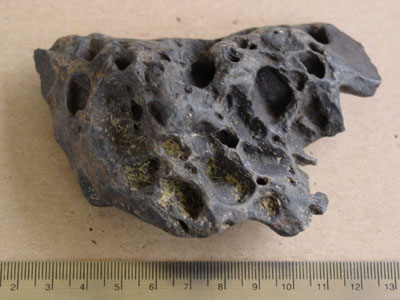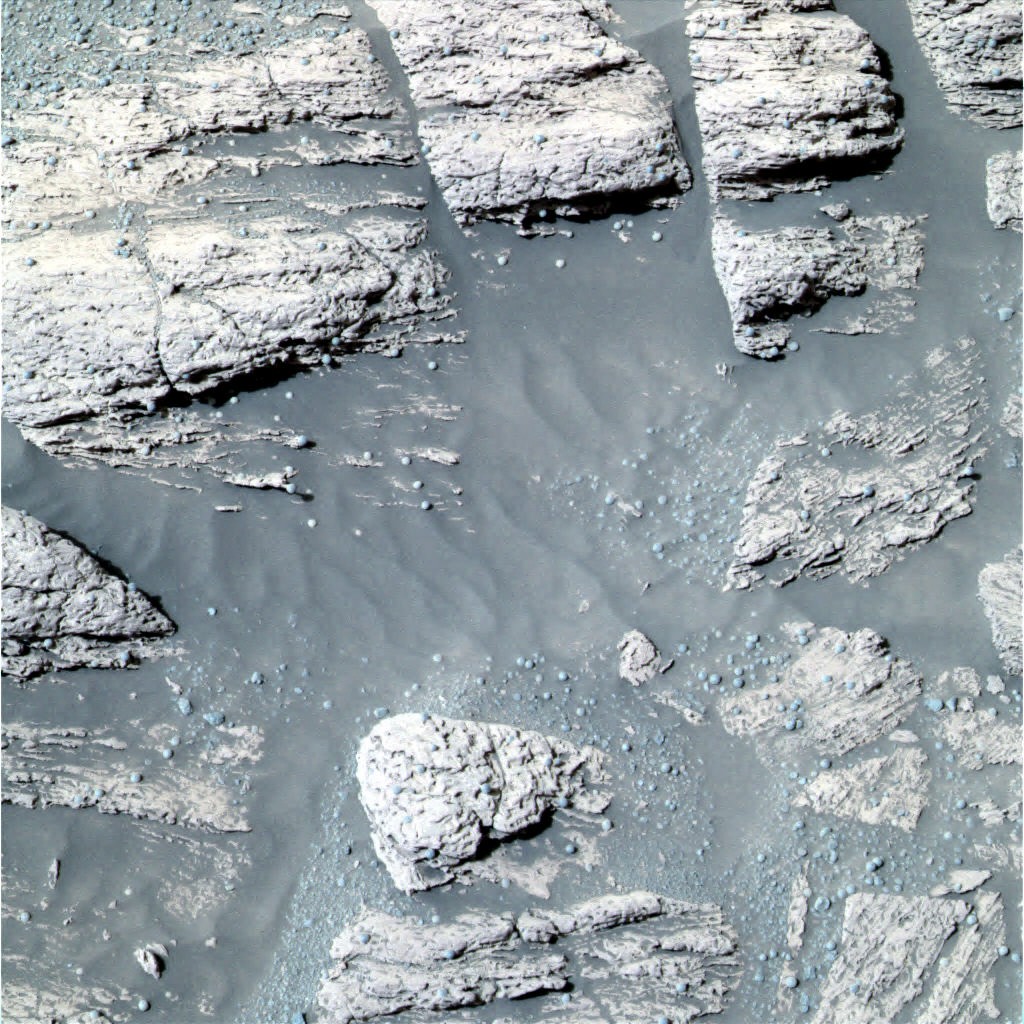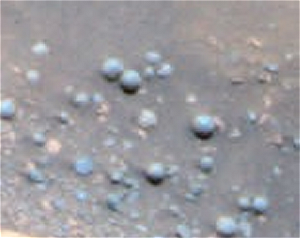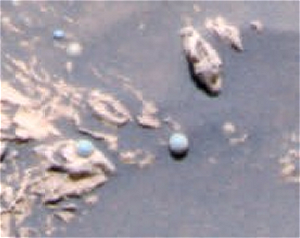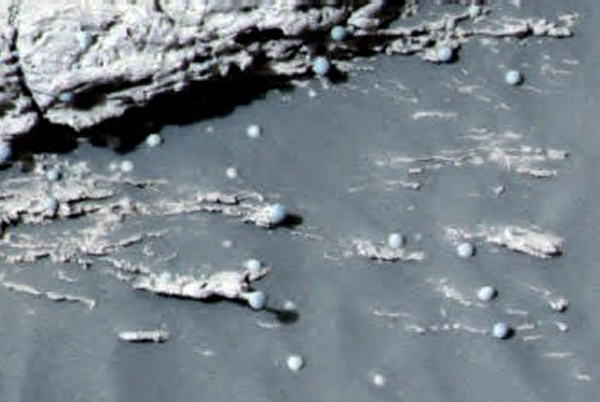It looks like you're using an Ad Blocker.
Please white-list or disable AboveTopSecret.com in your ad-blocking tool.
Thank you.
Some features of ATS will be disabled while you continue to use an ad-blocker.
share:
Originally posted by Blaine91555
reply to post by zorgon
That stuff from mars anomaly whatever is very suspect. Those rocks appear to be rhyolitic in nature with pockets from expected nodules. Rock looking like that is quite common on earth. Considering the amount of volcanism on Mars that rock should be expected. The nodules and geodes we see on earth come from that type of material and those rounded pockets are quite normal. I'm guessing that and its normally conchoidal fracture is what is giving that appearance. To make the leap to it being bone is one heck of a leap.
Similar material is very abundant south of Twin Falls Idaho and into Nevada. Whole areas are covered with material that looks like that. I will admit that I've reached for a piece thinking it was bone a time or three even though I knew there were no fossils in Igneous rock.
Mars Anomaly Research really should recruit a geologists. But then they would have to shut down the site
and I guess NASA should really recruit a biologist ,doesn't she?
see,it seems logical to me "my dear Watson" (couldn't resist)
that if I was a scientist working for NASA and searching for possible life on Mars, past or present,...
...that some rocks would indeed attract my attention, being fossil/bone like-ish that is...
I would use rovers apparattus to analyze such rocks of interest, on organic molecules to be precise, among all those rock and dirt geological deposit analyses of course...
for after all how can one differ a rock from a bone?
both are solid,quite the same colour and visual density...
all that may differ a bone from a rock up there ARE biological marks that coincide with a real bone anatomy
how can they know if they NEVER look for life remains other than ground molecular analysis?with all these suspectfull looking "rocks" lying out there...
well I guess they lack a biologist up there to tell them:
"hey,that could be a bone? or a fossil? let's analyze it for organics!"
they never do that...
cause rovers and landers up there don't even have the real organic analyzing apparatus to my knowledge...
at least not those that the geneal public knows of...
Originally posted by darkraver
Welllll... to me it looks really,really hipbone-ish
I guess it does also to all biologists out there...
but hey!
we are discussing life here aren't we?
fossils and remains and stuff?
guess it makes me kinnda more competent than an engineer to argue on this topic then...
Not when you offer no evidence to back up your claim.
right
I'm just offering more arguments than you in this case...
Evidence is not up to you or me...it's up to NASA since the agency is the ONLY evidential entity up there on Mars
Originally posted by darkraver
right
I'm just offering more arguments than you in this case...
What arguements are you presenting? That you have some form of biologist background and it looks that way to you?
Originally posted by darkraver
Evidence is not up to you or me...it's up to NASA since the agency is the ONLY evidential entity up there on Mars
Actually, if you're going to say you are 90% certain that a picture of a rock is a hipbone fossil, then you need to provide some structured reasoning, comparison, analysis and evidence why. You can't say 'well it looks like that to me, so it is' and expect people to believe you...
What arguements are you presenting? That you have some form of biologist background and it looks that way to you?
you are being childish...
look up the difference in terms between an argument and an evidence
....
Actually, if you're going to say you are 90% certain that a picture of a rock is a hipbone fossil, then you need to provide some structured reasoning, comparison, analysis and evidence why. You can't say 'well it looks like that to me, so it is' and expect people to believe you...
I provided structured reasoning,I provided comparison,other I cannot
but it's more than you could provide of it being a rock
sounded just like non-argumental one-liner debunking to me
btw you were going to sayyy...."that it looks to you like a rock, so it is"
please provide: structured reasoning,comparison,analysis and evidence why...
I don't expect anybody to believe to me, that is up to them
"deny ignorance,deny nonstructured debunking",that's my moto
you are being childish...
look up the difference in terms between an argument and an evidence
....
Actually, if you're going to say you are 90% certain that a picture of a rock is a hipbone fossil, then you need to provide some structured reasoning, comparison, analysis and evidence why. You can't say 'well it looks like that to me, so it is' and expect people to believe you...
I provided structured reasoning,I provided comparison,other I cannot
but it's more than you could provide of it being a rock
sounded just like non-argumental one-liner debunking to me
btw you were going to sayyy...."that it looks to you like a rock, so it is"
please provide: structured reasoning,comparison,analysis and evidence why...
I don't expect anybody to believe to me, that is up to them
"deny ignorance,deny nonstructured debunking",that's my moto
Originally posted by SlytOfHnd
For crying out loud armap, I would expect more from you.
Umm why are you picking on ArMaP? His contribution was finding that the two images were not as presented and worked hard to find the originals... I say he did a fine job on that...
Seriously some of you really need to read a bit better before tossing comments out
reply to post by darkraver
to get more to the subject at hand
here is another QUITE interesting picture from the "infamous" mr. Skipper

must be a rock...but leaving a snail-like trail behind?
it must be Phoenix playing a cat-mouse game with it
forgot the link:
www.nasa.gov...:
[edit on 29-8-2008 by darkraver]
to get more to the subject at hand
here is another QUITE interesting picture from the "infamous" mr. Skipper

must be a rock...but leaving a snail-like trail behind?
it must be Phoenix playing a cat-mouse game with it
forgot the link:
www.nasa.gov...:
[edit on 29-8-2008 by darkraver]
reply to post by zorgon
Zorgon, please lead me to the original image that the trilobite photo is from if you can? Thanks?
Zorgon, please lead me to the original image that the trilobite photo is from if you can? Thanks?
At this point I would just like to say well done and thank you to Zorgon and Armap!!
Had this have come from anyone but you two (or a select few other members )I would have to seriously consider the credibility of the info but considering the source I am satisfied.
I dont have much more than that at the moment until I have had time to digest it all.
Had this have come from anyone but you two (or a select few other members )I would have to seriously consider the credibility of the info but considering the source I am satisfied.
I dont have much more than that at the moment until I have had time to digest it all.
Originally posted by Blaine91555
I may be wrong but that looks like it has been manipulated, added or enhanced.
Yes that was the whole point it WAS maniputalted but until we found the originals to look at we had no way to know this...
Since the images are in the NASA presentation at the time there was only NASA's word... with no explanation
Now to have put all the data and full images into the thread would not have fit so I linked to THIS PAGE
www.thelivingmoon.com...
That has all the data, all the links to the original images we found and worked with. The reason I create the pages is so I don't have to repost it every time and slow down the thread loading anymore than I already do
Sadly few ever follow the links...
The point on this was that the presentation was not for the public in general but for a science symposium. I found it by fluke originally...
So was this done as a joke for the presentation, was it done to 'muddy the waters', or are the images we did find edited? Since there was no image # provided in the NASA paper... it took a long time to find them. Thanks to ArMaP for tracking them down
The rock 'Humphry' is a chuck of Basalt... its black that has been whitened and polished smooth by wind... As such there could be no fossil in it as basalt is volcanic not sedimentary...
So why did they chose to present it in that way? One image showing an obvious fossil Trilobite and the other an artifact?
I would have loved to hear that presentation
Originally posted by darkraver
you are being childish...
look up the difference in terms between an argument and an evidence
Don't call me childish. I know the difference, I'm not certain you do.
Originally posted by darkraver
I provided structured reasoning,I provided comparison,other I cannot
but it's more than you could provide of it being a rock
sounded just like non-argumental one-liner debunking to me
No, comparison is to post a picture of the kind of hipbone you are talking about and showing the similarities directly. I can easily provide evidence that it is a rock. It's on the surface of a planet and is neither animal nor vegitable manner, which leads me to thinking it;s mineral. Maybe it's metalic rather than rock.
Originally posted by darkraver
btw you were going to sayyy...."that it looks to you like a rock, so it is"
As there is no evidence, compelling or otherwise to the contrary, yes.
Originally posted by darkraver
please provide: structured reasoning,comparison,analysis and evidence why...
Nope. You are claiming it to be something other than what most ordinary observers would claim. It's your extroadinary claim, you provide the extroadinary evidence to back it up.
Originally posted by darkraver
I don't expect anybody to believe to me, that is up to them
Excellent, because untill you provide evidence, or more structured reasoning than 'it looks like kinda a hipbone', I won;t believe you.
Originally posted by darkraver
"deny ignorance,deny nonstructured debunking",that's my moto
Deny Ignorance and provide actual evidence of your claim, is mine. You are the one claiming that it is something not ordinary, so therefore, you must give proof for it. The burden is on the person proving something...
reply to post by darkraver
Is that a snail-like trail?
It looks nothing like the homogeneous, lubricated trails snails make, it looks more like a trail made by something that rolled over itself.
But this is just the opinion of self-taught programmer.
Is that a snail-like trail?
It looks nothing like the homogeneous, lubricated trails snails make, it looks more like a trail made by something that rolled over itself.
But this is just the opinion of self-taught programmer.
Hey zorgon, any chance you could suggest why you think that the images from the Nasa slideshow were not manipulated for the purposes of the lecture it
was for? To me they are obvious fakes used to prove a point, but keep mentioning it as if you think there is more to it.
Oh, and hey, you're talking about them again. Yet you told me that I was basically de-railing the thread when I questioned you earlier about them?...
Oh, and hey, you're talking about them again. Yet you told me that I was basically de-railing the thread when I questioned you earlier about them?...
reply to post by zorgon
It has got to be a joke. I found that rock in a pic I had. I don't know the source and I see you also have a copy. Here is a crop of the circled area and a little more.

You are correct. That is rhyolitic rock and no fossil is possible. I see some of the same type of rock as the supposed bones, also Igneous, with the expected pockets and conchoidal fracture.
They are playing a game. I did misunderstand at first.
It has got to be a joke. I found that rock in a pic I had. I don't know the source and I see you also have a copy. Here is a crop of the circled area and a little more.

You are correct. That is rhyolitic rock and no fossil is possible. I see some of the same type of rock as the supposed bones, also Igneous, with the expected pockets and conchoidal fracture.
They are playing a game. I did misunderstand at first.
The only reason Marsanomaly Research enters into this is because I gave credit to 'first find' to Skipper on the skull like objects... all the reats
are from NASA and Livingmoon...
Well not quite true my friend
Couple notes passed on to me from someone 'in the field'
"The Lunar Ranger utilized alpha-scatter identification capability along with LLRI capability used to determine soil composition... "
"For example, the Mars Rover (Spirit) is actually a micro-mining laboratory, complete with (2) spectrometers and other processing equipment/instrumentation. "
in another clip we have this...
marsrovers.nasa.gov...
Well since I am currently out of fossils I will toss in a few other minerals into the pot...
Originally posted by darkraver
cause rovers and landers up there don't even have the real organic analyzing apparatus to my knowledge...
at least not those that the general public knows of...
Well not quite true my friend
Couple notes passed on to me from someone 'in the field'
"The Lunar Ranger utilized alpha-scatter identification capability along with LLRI capability used to determine soil composition... "
"For example, the Mars Rover (Spirit) is actually a micro-mining laboratory, complete with (2) spectrometers and other processing equipment/instrumentation. "
Scientists today reported initial impressions from using Spirit's alpha particle X-ray spectrometer, Mössbauer spectrometer and microscopic imager on a patch of soil that was directly in front of the rover after Spirit drove off its lander Jan. 15.
"We're starting to put together a picture of what the soil at this particular place in Gusev Crater is like. There are some puzzles and there are surprises," said Dr. Steve Squyres of Cornell University, Ithaca, N.Y., principal investigator for the suite of instruments on Spirit and on Spirit's twin, Opportunity.
One unexpected finding was the Mössbauer spectrometer's detection of a mineral called olivine, which does not survive weathering well. This spectrometer identifies different types of iron-containing minerals; scientists believe many of the minerals on Mars contain iron. "This soil contains a mixture of minerals, and each mineral has its own distinctive Mössbauer pattern, like a fingerprint," said Dr. Goestar Klingelhoefer of Johannes Gutenberg University, Mainz, Germany, lead scientist for this instrument.
The lack of weathering suggested by the presence of olivine might be evidence that the soil particles are finely ground volcanic material, Squyres said. Another possible explanation is that the soil layer where the measurements were taken is extremely thin, and the olivine is actually in a rock under the soil.
Scientists were also surprised by how little the soil was disturbed when Spirit's robotic arm pressed the Mössbauer spectrometer's contact plate directly onto the patch being examined. Microscopic images from before and after that pressing showed almost no change. "I thought it would scrunch down the soil particles," Squyres said. "Nothing collapsed. What is holding these grains together?"
in another clip we have this...
Information from another instrument on the arm, an alpha particle X-ray spectrometer, may point to an answer. This instrument "measures X-ray radiation emitted by Mars samples, and from this data we can derive the elemental composition of Martian soils and rocks," said Dr. Johannes Brueckner, rover science team member from the Max Planck Institute for Chemistry, Mainz, Germany. The instrument found the most prevalent elements in the soil patch were silicon and iron. It also found significant levels of chlorine and sulfur, characteristic of soils at previous Martian landing sites but unlike soil composition on Earth.
marsrovers.nasa.gov...
Well since I am currently out of fossils I will toss in a few other minerals into the pot...
reply to post by zorgon
That artifact, I believe, is not a verified image but more a possibility given the PDF document it comes from has a scale with images, going from null (barren terrain) to unfathomable (this artifact).
And to be honest, it looks like an old car door handle. Id not put too much consideration into those images, they seem to be more thought provoking items rather than evidence towards artifacts/life on mars.
Otherwise great thread !!

That artifact, I believe, is not a verified image but more a possibility given the PDF document it comes from has a scale with images, going from null (barren terrain) to unfathomable (this artifact).
And to be honest, it looks like an old car door handle. Id not put too much consideration into those images, they seem to be more thought provoking items rather than evidence towards artifacts/life on mars.
Otherwise great thread !!

Here is a picture of the salts stirred up using the Rover wheels as a digging tool..
Spirit :: Panoramic Camera :: Sol 788
Here is a specimen of Vesicular Basalt from the same location
Spirit :: Panoramic Camera :: Sol 736
And here is a piece from Nevada in my collection - for color reference
Spirit :: Panoramic Camera :: Sol 788
Here is a specimen of Vesicular Basalt from the same location
Spirit :: Panoramic Camera :: Sol 736
And here is a piece from Nevada in my collection - for color reference
reply to post by Vector J
well ,if i really must...
here you go:
images.google.hr...://www.spjc.edu/hec/VT/VTDE/Anatomy/images/07_pelvis_sacrum.jpg&imgrefurl=http://www.spjc.edu/hec/VT/VTDE/An atomy/3a.htm&h=768&w=574&sz=250&hl=hr&start=139&sig2=EYzBLn3waZEdhuXoRbXKnA&um=1&usg=__ulKiWodjJCV160t4mFTVbBN6y9E=&tbnid=HLXg9WjiyLNdEM:&tbnh=142&tbn w=106&ei=aqu4SJWPHoHW0AWrkcDyAQ&prev=/images%3Fq%3Ddog%2Bpelvis%26start%3D120%26ndsp%3D20%26um%3D1%26hl%3Dhr%26client%3Dfirefox-a%26rls%3Dorg.mozilla: en-USfficial%26sa%3DN
images.google.hr...://www.spjc.edu/hec/VT/VTDE/Anatomy/images/07_pelvis_sacrum.jpg&imgrefurl=http://www.spjc.edu/hec/VT/VTDE/An atomy/3a.htm&h=768&w=574&sz=250&hl=hr&start=139&sig2=EYzBLn3waZEdhuXoRbXKnA&um=1&usg=__ulKiWodjJCV160t4mFTVbBN6y9E=&tbnid=HLXg9WjiyLNdEM:&tbnh=142&tbn w=106&ei=aqu4SJWPHoHW0AWrkcDyAQ&prev=/images%3Fq%3Ddog%2Bpelvis%26start%3D120%26ndsp%3D20%26um%3D1%26hl%3Dhr%26client%3Dfirefox-a%26rls%3Dorg.mozilla: en-USfficial%26sa%3DN
although you must put it in a right perspective,be visual...
hope you're able to see the similarities...I just "dun't have the time to picture it for ya'"
well ,if i really must...
here you go:
images.google.hr...://www.spjc.edu/hec/VT/VTDE/Anatomy/images/07_pelvis_sacrum.jpg&imgrefurl=http://www.spjc.edu/hec/VT/VTDE/An atomy/3a.htm&h=768&w=574&sz=250&hl=hr&start=139&sig2=EYzBLn3waZEdhuXoRbXKnA&um=1&usg=__ulKiWodjJCV160t4mFTVbBN6y9E=&tbnid=HLXg9WjiyLNdEM:&tbnh=142&tbn w=106&ei=aqu4SJWPHoHW0AWrkcDyAQ&prev=/images%3Fq%3Ddog%2Bpelvis%26start%3D120%26ndsp%3D20%26um%3D1%26hl%3Dhr%26client%3Dfirefox-a%26rls%3Dorg.mozilla: en-USfficial%26sa%3DN
images.google.hr...://www.spjc.edu/hec/VT/VTDE/Anatomy/images/07_pelvis_sacrum.jpg&imgrefurl=http://www.spjc.edu/hec/VT/VTDE/An atomy/3a.htm&h=768&w=574&sz=250&hl=hr&start=139&sig2=EYzBLn3waZEdhuXoRbXKnA&um=1&usg=__ulKiWodjJCV160t4mFTVbBN6y9E=&tbnid=HLXg9WjiyLNdEM:&tbnh=142&tbn w=106&ei=aqu4SJWPHoHW0AWrkcDyAQ&prev=/images%3Fq%3Ddog%2Bpelvis%26start%3D120%26ndsp%3D20%26um%3D1%26hl%3Dhr%26client%3Dfirefox-a%26rls%3Dorg.mozilla: en-USfficial%26sa%3DN
although you must put it in a right perspective,be visual...
hope you're able to see the similarities...I just "dun't have the time to picture it for ya'"
reply to post by bloodcircle
Genius. Star for you my friend! That's uncanny! Whether or not that is infact the kind of object they used for their mock up, that is an excellent suggestion.
See rorshach guys. this is what i'm talking about. comparable things. If you say 'hey, this is a building!' or 'whoa, this is a hipbone!' and provide no coroborating evidence, what water does that arguement hold? And here we have bloodcircle saying, hey that looks fake, and here is an almost perfect example of what I think they used for it.
Thanks bloodcircle, thats a bloody brilliant post!...
Genius. Star for you my friend! That's uncanny! Whether or not that is infact the kind of object they used for their mock up, that is an excellent suggestion.
See rorshach guys. this is what i'm talking about. comparable things. If you say 'hey, this is a building!' or 'whoa, this is a hipbone!' and provide no coroborating evidence, what water does that arguement hold? And here we have bloodcircle saying, hey that looks fake, and here is an almost perfect example of what I think they used for it.
Thanks bloodcircle, thats a bloody brilliant post!...
And here are the Hematite nodules in sedimentary rock that NASA has labeled "Blueberries" Gotta love those scientists eh?
Opportunity :: Panoramic Camera :: Sol 037
A few close ups
[ats]http://www.thelivingmoon.com/43ancients/04images/Mars4/Opportunity_Sol_037/Blue_004.png[ats]
Opportunity :: Panoramic Camera :: Sol 040
But my absolute favorite is THIS one.. Mike Singh's MARTIAN SNAIL
[edit on 29-8-2008 by zorgon]
Opportunity :: Panoramic Camera :: Sol 037
A few close ups
[ats]http://www.thelivingmoon.com/43ancients/04images/Mars4/Opportunity_Sol_037/Blue_004.png[ats]
Opportunity :: Panoramic Camera :: Sol 040
But my absolute favorite is THIS one.. Mike Singh's MARTIAN SNAIL
[edit on 29-8-2008 by zorgon]
reply to post by darkraver
Yes. You must.
Sadly your links don;t work. And I don;t care if you show me a picture of a huge amount of hipbones. You need to show one in a similar orientation and highlight the similarities in the original Mars picture you used...
Yes. You must.
Sadly your links don;t work. And I don;t care if you show me a picture of a huge amount of hipbones. You need to show one in a similar orientation and highlight the similarities in the original Mars picture you used...
new topics
-
'Proud Prophet' 12 Day Exercise Predicted Global Nuclear Catastrophe
World War Three: 3 hours ago -
Never say Never?
Science & Technology: 6 hours ago
top topics
-
Lies lies lies, green energy is black.
The Gray Area: 13 hours ago, 11 flags -
Never say Never?
Science & Technology: 6 hours ago, 8 flags -
'Proud Prophet' 12 Day Exercise Predicted Global Nuclear Catastrophe
World War Three: 3 hours ago, 2 flags -
Ford Motor Company sold to Elon Musk
Ludicrous Online Lies: 17 hours ago, 1 flags
active topics
-
Mass UAP events. DC. Machester Airport, UFOs over sub base in CT, Nuke bases.
Aliens and UFOs • 50 • : TheValeyard -
The Reactionary Conspiracy 13. The plot’s theology.
General Conspiracies • 319 • : andy06shake -
Unidentified Flying Objects Over U.S. Military Bases in Northeast UK, as of roughly 11 a.m. CST.
Aliens and UFOs • 38 • : TheValeyard -
Post A Funny (T&C Friendly) Pic Part IV: The LOL awakens!
General Chit Chat • 7862 • : watchitburn -
DefCon Teetering on Escalation
World War Three • 48 • : TheValeyard -
Salvatore Pais confirms science in MH370 videos are real during live stream
General Conspiracies • 35 • : Lazy88 -
'Proud Prophet' 12 Day Exercise Predicted Global Nuclear Catastrophe
World War Three • 8 • : Oldcarpy2 -
Lies lies lies, green energy is black.
The Gray Area • 24 • : CriticalStinker -
President-Elect Trump Picks Indian-American KASHYAP P. PATEL for F.B.I. Director.
2024 Elections • 47 • : DBCowboy -
Biden pardons his son Hunter despite previous pledges not to
Mainstream News • 89 • : BernnieJGato

